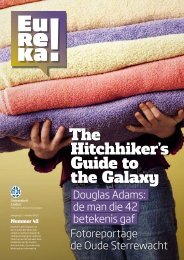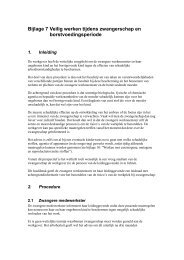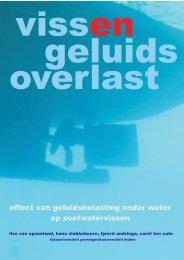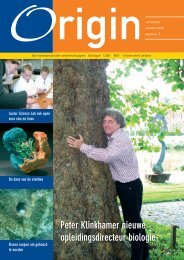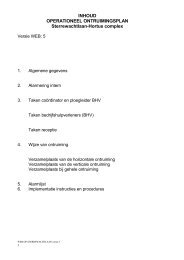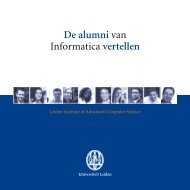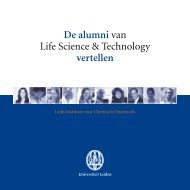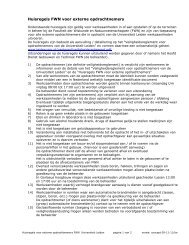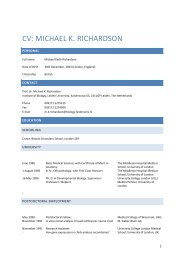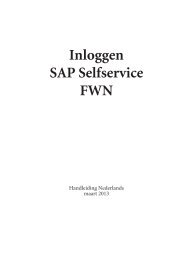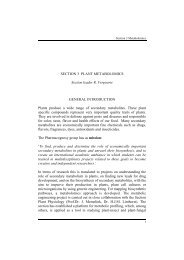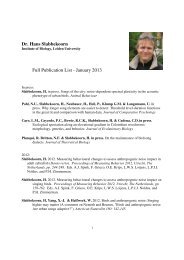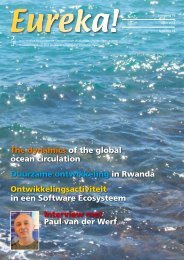infinite Beauty - Faculteit der Wiskunde en Natuurwetenschappen
infinite Beauty - Faculteit der Wiskunde en Natuurwetenschappen
infinite Beauty - Faculteit der Wiskunde en Natuurwetenschappen
Create successful ePaper yourself
Turn your PDF publications into a flip-book with our unique Google optimized e-Paper software.
Figure 1: The Louvre museum houses a lot of artwork in which the gold<strong>en</strong> ratio is used. The Louvre pyramid doesn’t<br />
house this ratio, unlike the pyramid of Gizeh, which does. (Photo: K. Kap).<br />
number is φ, phi, and the proportion it describes is<br />
known as ‘the gold<strong>en</strong> ratio’ (box 1).<br />
iron Cakes<br />
This mysterious number caught att<strong>en</strong>tion of painters,<br />
biological researchers and architects and was oft<strong>en</strong><br />
used in their work, both int<strong>en</strong>tionally and unint<strong>en</strong>tionally.<br />
Throughout history, people from differ<strong>en</strong>t<br />
disciplines were grasped by the divine ratio, used it<br />
in their art works and looked for it everywhere in nature.<br />
Iron cakes might accompany this sequ<strong>en</strong>ce.<br />
Iron cakes are not made from iron, but are baked on<br />
a specific iron plate. This plate has a pattern of rhombuses<br />
on it. Wh<strong>en</strong> the ratio of the diagonals of the<br />
rhombus on an iron cake baking plate is equal to ϕ,<br />
that rhombus is called a gold<strong>en</strong> rhombus. These gold<strong>en</strong><br />
rhombuses can also be found in arrangem<strong>en</strong>ts of<br />
molecules 2 .<br />
Wh<strong>en</strong> a gold<strong>en</strong> ratio is found somewhere, one could<br />
assume that an object is self-similar. Self-similarity<br />
occurs wh<strong>en</strong> a subject at a smaller scale looks like<br />
itself, as it is the case for the line described in box<br />
1, an arrangem<strong>en</strong>t of gold<strong>en</strong> rhombuses on a baking<br />
plate or a crystalline arrangem<strong>en</strong>t in a molecular<br />
structure.<br />
self-similarity<br />
If there is one thing that supports the interesting theory<br />
opposed by R. L. Ol<strong>der</strong>shaw, convinced of the<br />
significance of his finding, it is the gold<strong>en</strong> ratio. He<br />
proposes a Self-Similar Cosmological Paradigm that<br />
proposes that nature is or<strong>der</strong>ed in a transfinite, which<br />
is not <strong>infinite</strong>, but more than finite, hierarchy of discrete<br />
cosmological scales. 3-4<br />
Box 1: The ratio of the l<strong>en</strong>gth of fragm<strong>en</strong>ts<br />
α:β = (α+β): α, is called the gold<strong>en</strong> ratio<br />
α β<br />
This gold<strong>en</strong> ratio is an irrational number,<br />
indicated by φ.<br />
This ratio is thought to be important in<br />
defining some properties of beauty.<br />
This self-similarity can be found everywhere: in fractals,<br />
molecules, and also in pyramids. Interestingly<br />
<strong>en</strong>ough, the gold<strong>en</strong> ratio is also found all sorts of<br />
organisms in nature. Especially people who work on<br />
phyllotaxis, the study of leaf arrangem<strong>en</strong>ts, come into<br />
contact with this ratio very oft<strong>en</strong>. The number of petals<br />
for example, is oft<strong>en</strong> a Fibonacci number. And the<br />
Fibonacci numbers are related to the gold<strong>en</strong> ratio, as<br />
explained in box 2.<br />
It is thought that both people and bees are attracted<br />
by flowers because of the Fibonacci numbers that occur<br />
in the arrangem<strong>en</strong>t of flower leaves and petals.<br />
Architects and painters use because they believe it is<br />
a number of “divine proportions” and believe that it<br />
describes some kind of ideal ratio.<br />
Change your face<br />
Gunes and Piccardi 5 found that the gold<strong>en</strong> ratio is a<br />
good descriptor of the way in which facial features<br />
should relate to each other to nominate a face as attractive.<br />
They programmed a computer in such a way<br />
that the program could assess facial beauty with the<br />
use of rules of proportion based on the gold<strong>en</strong> ratio.<br />
math in nature<br />
origin - universiteit leid<strong>en</strong> 19



